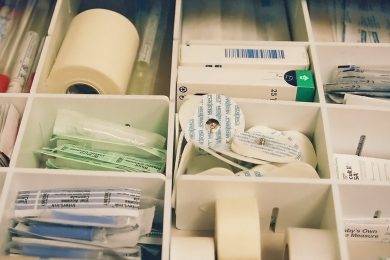According to one study, 99% of healthcare providers have experienced challenges related to product procurement over the past year.
The recent COVID-19 pandemic has highlighted global supply chain issues in almost every sector. This industry is no exception.
As a result, we’re seeing widespread shortages of critical supplies. These include personal protective equipment (PPE), cleaning tools, and more.
As we move slowly into a post-pandemic economy, what does the future of the medical supply chain look like? Today, we’re sharing the measures that providers are putting in place to mitigate these risks and create more resiliency.
A Brief Look at the Current Medical Supply Chain
Right now, prices for commodity goods and services are still surging. From raw materials and warehousing to transportation and logistics, it’s harder than ever to procure what we need. Operations managers are struggling to offset the opposing forces of customer demands and material scarcities.
These shortcomings are strongly felt in the medtech supply chain. Here, providers are trying to procure the key items they need to do their jobs, from PPE to crutches.
This disruption makes day-to-day work difficult. It also impacts patient care levels. In addition, it can create turmoil within a healthcare office, leading to issues such as:
- Staff burnout
- Wage inflation
- High turnovers
- Difficulty filling vacancies
On top of the pandemic, there are other issues at play that can threaten the healthcare supply chain. These include:
- Natural disasters
- Climate change
- Shaky economic conditions
- The threat of cyberattacks
All of these variables can place a great strain on the healthcare system. Yet, savvy providers are looking for ways to safeguard their practices as much as possible.
Let’s take a look at some of the strategies they’re employing to build more resilient and agile supply chains.
Improved Forecasting
Medical supply chain issues can’t be directly avoided at all costs. However, companies can sidestep lengthy delays and shipping issues by investing in advanced forecasting technologies.
These tools allow decision-makers to analyze trending patterns in patient care to predict and prepare for new surges. No longer is it enough to base their next steps on the past 30 days or historical trends.
Now, they need real-time updates on what’s happening in their industry, across both clinical and non-clinical settings. They can use this data to plan ahead and order the supplies they need before the demand rises.
Thankfully, the field of healthcare data analytics is becoming more robust. Cloud computing enables stakeholders to stay updated on their own internal operations. They can also keep an eye on the global events that could impact them.
With those insights in hand, they can make requisite adjustments on their end. This allows them to accommodate for issues such as shipping delays and long product lead times.
More Detailed Risk Assessments
Risk assessments are important in any sector, but they’re especially vital for healthcare providers.
This process requires listing out your perceived risks and identifying any potential sources of disruption. What might happen down the road and what would the fallout include?
For example, some of the most prominent risks emerging from the pandemic include:
- Logistical challenges and bottlenecks
- Lack of healthcare workers to move products (absenteeism)
- Slow movement of supplies
- Export bans placed on PPE and other equipment
Forward-thinking providers can look at these risks and analyze which strategies they can use to overcome them. This might mean revamping outdated best practices. Or, it could require different workflows and new partnerships.
For example, some might choose to carry extra inventory to shield their companies against product delays. Others might ramp up their manufacturing capacity to prevent workplace declines. Then, there are some that will invest in backup suppliers in case their current ones aren’t able to meet their demands.
All of these steps can go a long way toward building redundancy into the healthcare supply chain.
Increased Emphasis on Compliance
With supply chain issues tugging at their attention, healthcare providers can’t afford to experience other, avoidable setbacks. As such, they’re investing in software solutions that can help them maintain industry compliance.
Platforms like MedPro Systems® DSCSA Compliance Solutions help them understand the steps required to stay aligned with critical regulations, such as the Drug Supply Chain Security Act (DSCSA). This helps workers across the pharmaceutical supply chain achieve the license validation they require for DSCSA compliance.
Supplier Diversification
Supplier diversification is key to building resiliency into every facet of healthcare.
Instead of relying solely on one provider, smart companies are looking to build strong relationships with multiple providers. This way, they’re covered in the event of a shortage.
This movement was catalyzed in the early days of the pandemic. At that time, only certain suppliers were certified to export PPE gear to the US. This list changed on a constant basis, which threw the entire supply chain into flux.
As customs checks grew more stringent, there were inevitable delays and disruptions. This led to nationwide PPE shortages at a time when this gear was needed the most.
To avoid future delays, companies must partner with suppliers that have quick access to the materials they need. They should also be reputable and financially sound.
The Future of the Medical Supply Chain
It remains to be seen whether this recent slowdown of COVID cases means we’re moving toward a more stable economy. As supply chain issues continue, the medical sector is paying close attention.
Providers are diversifying suppliers, forecasting, and assessing risks to fortify the medical supply chain. They’re also using compliance software to maintain alignment with shifting industry regulations.
With these tools, they’re taking steps to become more self-sufficient and agile. As they do, we’re here to keep you updated on the latest news. Check out our Health section for more guides!











